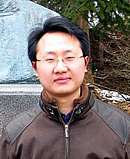|
|
| Details of the Faculty or Staff |
|
Name |
WANG Jian |
Title |
Professor |
|
Highest Education |
Ph.D. |
Subject Categories |
Geophysics |
|
Phone |
010-82998600 |
Zip Code |
100029 |
|
Fax |
010-62010846 |
Email |
jianwang@mail.iggcas.ac.cn |
|
Office |
No.19 Beitucheng West Road, Chaoyang District, Beijing, 100029, China |
|

|
| Education and Appointments: |
Education:
- 2000.9-2005.7, Ph.D.(Master-Doctor program: a continuous academic project that involves postgraduate and doctoral study) in Geophysics, Institute of Geology & geophysics, Chinese Academy of Sciences.
- Thesis Advisor: Professor Zheng-Ren Ye Thesis Topic: The basic theory of mantle convection and its applications in explaining some geophysical observations(in Chinese)
- 1996.9-2000.7, B.S.,Flight Vehicle Design & Applied Mechanics,Beijing University of Aeronautics & Astronautics, China.
Work Experience:
- 2011.1-2011.3, Academic exchange, Department of Geophysics, Tohoku University, Sendai, Japan.
- 2008.12-2019.12, Associate Professor, Institute of Geology & geophysics, Chinese Academy of Sciences.
- 2005.7-2008.12, Post-doctoral fellow,Institute of Geology & geophysics, Chinese Academy of Sciences. Advisor: Academician Zhen-Xing Yao & Professor Ming-Guo Zhai
- 2007.6-2008.5, Post-doctoral fellow, Department of Geophysics, Tohoku University, Sendai, Japan. Advisor: Professor Dapeng Zhao
- 2020.1-Present, Professor, Institute of Geology & Geophysics, Chinese Academy of Sciences.
|
| Research Interests: |
1. Anisotropic Tomography:
So far many researchers have studied the heterogeneous structure of the crust and upper mantle with isotropic tomography method, which have greatly advanced our understanding of seismotectonics, magmatism and geodynamics in the Earth. Some researchers have studied seismic anisotropy by shear-wave splitting measurements. However, anisotropic bodies may exist extensively in different parts, such as the subducting slab, the mantle, the ductile lower crust, and the brittle upper crust. This complexity makes it difficult to figure out exactly where and how the anisotropy originates from the shear-wave splitting measurements alone. We modified the tomographic method of Zhao et al. (1992) to invert for velocity heterogeneity, azimuthal anisotropy, and radial anisotropy beneath the Japan Islands, which resulted in a better understanding of the structure and dynamics of this region. We plan to apply this method to other regions, such as North China Craton, Tibetan Plateau, Iranian Plateau, etc.
2. Dynamic Modeling:
We applied the 3-D finite-element method to the abundant GPS data in China to study the crustal deformation, stress field and dynamics in China. The influences caused by the India-Eurasia collision, the gravitational poential energy fifference of the Tibet Plateau, the mantle convection and the large-scale faults were taken into account. I plan to use dislocation model to study the present-day crustal deformation and the features of some large-sacle faults in China |
| Supported Projects: |
-
The numerical simulation about the effect on China continental crustal movement caused by mantle convection (National Natural Scientific Foundation of China, No. 40604011, 2007.01-2009.12);
-
P-wave anisotropic tomography of the crust beneath Beijing and surrounding regions (National Natural Scientific Foundation of China, No. 40974026, 2010.01-2012.12).
-
P-wave anisotropic tomography of the crust and upper mantle beneath the North China Craton (National Natural Scientific Foundation of China, No. 41074060, 2011.01-2013.12).
- Tomography for the heterogeneity and anisotropy beneath subduction zone in Japan (National Natural Scientific Foundation of China, No. 41274089, 2013.01-2016.12)
|
| Publications: |
-
Wang, J., H. Wu, and D. Zhao (2014), P wave radial anisotropy tomography of the upper mantle beneath the North China Craton, Geochem. Geophys. Geosyst., 15, 2195–2210, doi:10.1002/2014GC005279.
-
Wang, J., Zhao, D., 2013. P-wave tomography for 3-D radial and azimuthal anisotropy of Tohoku and Kyushu subduction zones. Geophys. J. Int. 193, 1166-1181. (In the ranking at 24 of the top 50 most-read articles in GJI during May 2013, at 16 during June 2013, at 46 during October 2013, at 30 during December 2013).
-
Wang, J., Zhao, D., Yao, Z., 2013. Crustal and uppermost mantle structure and seismotectonics of North China Craton. Tectonophysics 582, 177-187.
-
Wang, J., Zhao, D., 2012. P wave anisotropic tomography of the Nankai subduction zone in Southwest Japan. Geochem. Geophys. Geosyst. 13(1), doi:10.1029/2012 GC004081.
-
Wang, J., Zhao, D., 2010. Mapping P-wave anisotropy of the Honshu arc from Japan Trench to the back-arc. J. Asian Earth Sci. 39, 396-407.
-
Wang, J., Zhao, D., 2009. P-wave anisotropic tomography of the crust and upper mantle under Hokkaido, Japan. Tectonophysics 469, 137-149.
-
Wang, J., Zhao, D., 2008. P-wave anisotropic tomography beneath Northeast Japan. Phys. Earth Planet. Inter. 170, 115-133.
-
Wang, J., Ye, Z., He, J., 2008. Three-dimensional mechanical modeling of large-scale crustal deformation in China constrained by the GPS velocity field. Tectonophysics 446, 51-60.
-
Wang, J., Ye, Z., 2006. Dynamic modeling for crustal deformation in China: Comparisons between the theoretical prediction and the recent GPS data. Phys. Earth Planet. Inter. 155, 201-207.
-
Wang, J., Ye, Z., 2005. Effects of mantle flow on generation and distribution of global lithospheric stress field. Chinese J. Geophys. (in Chinese) 48(3), 584-590.
-
Ye, Z., Wang, J., 2004. Dynamics of present-day crustal movement in the China mainland. Chinese J. Geophys. (in Chinese) 47(3), 456-461.
-
Ye, Z., Wang, J., 2003. A numerical research on the small-scale convection with variable viscosity in the upper mantle. Chinese J. Geophys. (in Chinese) 46(3), 335-339.
- Ye, Z., Wang, J., 2002. Global heat flow simulation based on a kinematic model of mantle flow. Geophys. J. Int. 148, 329-335
|
|
|
|
|
|
|
COPYRIGHT @ INSTITUTE OF GEOLOGY AND GEOPHYSICS CHINESE ACADEMY OF SCIENCES (IGGCAS)
No. 19, Beitucheng Xilu, Chaoyang District, 100029, Beijing, PR China
Tel:010-82998001 Fax:010-62010846 Email:suoban@mail.iggcas.ac.cn |
|